Ultimate PR Crisis Communication Plan

Do you know what to do if a public relations crisis happens in your organization? Have you a PR crisis communication plan in the event that you are parachuted into the media spotlight for all the wrong reasons?
Fail to prepare, prepare to fail, but not if you follow my 15-step best practice PR crisis communication plan.
In business and in life your reputation is everything. It is in fact more valuable than money, because if you lose your good reputation, losing business will likely be the immediate impact.
[tweetthis]Being prepared for a PR crisis will help mitigate the damage to your brand, your business and your bottom line.[/tweetthis]
I have been on all sides of PR crises throughout my 15 year communications career – as a journalist, a PR consultant, a business owner and even as a reality TV show contestant. So I have dealt with many crises in many guises over the years. My advice in this blog post is based on handling many real life PR crises.
Do you want to know how to put the fire out on a PR nightmare on social media?
Social media, community and digital marketing managers don’t always come with a PR background so it’s important your management team meet to discuss the potential for any PR crisis on your social networks and have a plan in place.
[tweetthis] Do you know how to deal with a PR crisis? Download the 15-step action plan. #PRtips[/tweetthis]
15-step PR crisis communication plan
1) Establish the facts first
When a crisis breaks there is a real danger that a CEO will go into crisis shock and immediately go on the defense. Your first role as a manager is to remain composed, establish the facts and ask the right questions.
-
What is the crisis?
You need to be able to nail down exactly what the crisis is because you are preparing a communications plan based on this. So succinctly describe the crisis in one paragraph, because that’s exactly what the media will do. This will help you focus on the core issue and thus deal with it and not sidelines matters.
-
Who is involved?
Being able to identify the main protagonists in the crisis is vital. Apart from you or your organization who else is impacted by this crisis? Is it another company, another person (staff member, customer, supplier, creditor, business partner), a regulatory agency or a state body? Don’t forget the media will be involved so keep them high up on your list of ‘who’s involved’?
-
How did it happen?
You must tie down how the crisis evolved and ultimately erupted. This is necessary in order to be able to communicate the facts. It might be the case that a series of unfortunate events led to this crisis, so ensure you track every incident, episode, action and reaction so that you are not operating in a communications silo.
-
Where did it happen?
The location of the crisis is probably where the media will descend on first. Is the crisis contained to one location – a company premises, an international location, a third party location – or does it involve multiple locations. You will have to have expertise on site at each relevant location to deal with the media who will inevitably show up with camera crews and their smart phones.
-
Why did it happen?
This is probably the most important question to answer. You need to be able to answer this question for yourself but also for the media. If you cannot explain why it happened then it goes without saying that you will not nor cannot learn from the crisis so as to ensure it won’t happen again.
-
When did it happen?
You must document a timeline of events leading up to the crisis and you must delegate the task of documenting all current and future actions also. This will help you manage any fallout from the crisis. Having a timeline will also give you valuable visibility in chronicling the steps that led you to now.
2) The golden hour response
[tweetthis]What you do in the 1st hour of a communications crisis will determine how your PR crisis will unfold[/tweetthis]
This is why it is called the ‘golden hour’. Do not lock yourself in a room to hide away or to have ‘thinking time’, you need to take action with your team. The following infographic depicts what action should be taken in the first 60-minutes involving your team.

3) ‘No comment’ is not an option
Trust me on this one. What do you think when you hear the words ‘no comment?’ Yes, me too. We immediately think ‘what do they have to hide’ or ‘there’s no smoke without fire.’
The media will always find their story and whether you comment or not, they will have a story about you. This is why you should control the story as much as possible in terms of giving them accurate, timely and relevant information. It also shows trust and transparency when a company comes out so prepare that media statement.
4) Monitor your brand across all media types
If you are not doing so already, set up brand monitoring for your organization’s name, the CEO’s name and anyone else involved in the crisis.
[tweetthis]By monitoring your brand during a PR crisis, you can react in real-time as needed while gauging brand sentiment [/tweetthis]
Monitoring services are offered by a range of companies, but make sure you monitor traditional media, online media and social media. Not all monitoring companies offer blanket offline and online monitoring.
There are also some free monitoring tools available, which you can maximize if you don’t have a large budget.
Here’s a comprehensive list of 46 free social media monitoring tools from Dreamgrow.com.
Google News
Use Google News to search for top news in your country, state or region. You must localize it to your own location and you can also search for news categories such as business.
Google News Archive
Google news archive search provides an easy way to search and explore historical archives. In addition to helping you search, news archive search can automatically create timelines, which show selected results from relevant time periods.
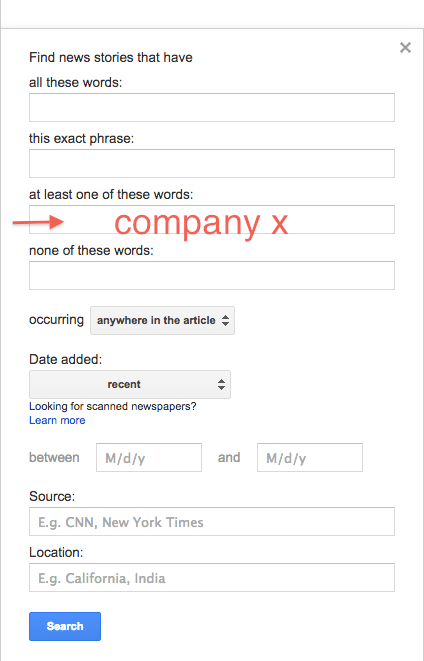
Google Alerts
Set up a Google Alert for your company name and/or CEO or specific person involved in the crisis. You can add keywords and publications as well as make it location-specific. You also set how often you want updates emailed to you, so of course in the case of a PR communications crisis you should opt for ‘as it happens.’ Ensure somebody is monitoring the email address linked to your Google Alert.
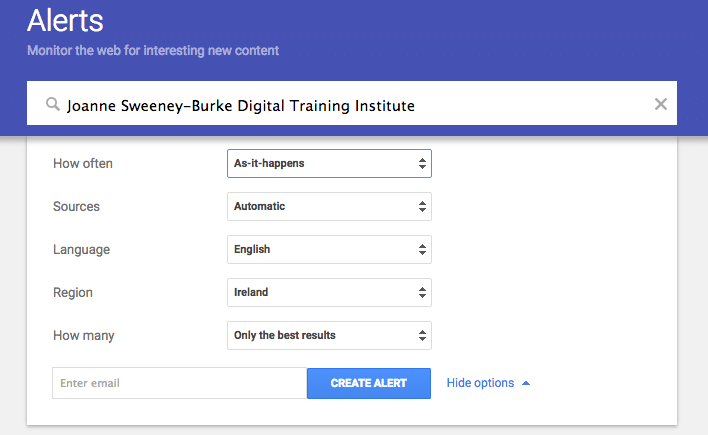
Set up your Google Alert for PR Crisis Communications Plan
Omgili
This tool, Omgili (oh my god I love it) is a specialized search engine that focuses on “many to many” user generated content platforms, such as, forums, discussion groups, mailing lists, answer boards and others. It finds consumer opinions, debates, discussions, personal experiences, answers etc.

Here’s a wiki of social media monitoring solutions.
These are the monitoring services that I use for in my business in Ireland.
- Newsaccess for print, radio and TV monitoring;
- Zenark for online news website monitoring; and
- Sendible for social media monitoring.
5) Prepare your statement
A media statement is an invaluable part of your communications crisis toolbox. It will establish the facts for the media, the public, your customers, staff and any other relevant stakeholders. If the facts are not publicly shared then there leaves lots of opportunity for rumor and hearsay to gather momentum and you want to prevent this at all costs.
Don’t forget that if an apology is required in your crisis, say it. The media will ask you that question first if you ignore this in your statement.
[tweetthis]Download @tweetsbyJSB free template crisis communication press release #PRcrisis #PRtips[/tweetthis]
Download my template crisis communications press release

6) Brief internal stakeholders first
Before you brief the media brief internal stakeholders first including Board of Directors, staff, customers, suppliers, volunteers, freelancers or agents. They can be given a short outline of the crisis and what action you are taking. It can be a shorter version of the media statement or a copy of it. I would schedule the email to go to internal stakeholders 3-5 minutes before it goes to the media.
7) Media engagement
You should have a media list on file at all times, but if you don’t call the main media outlets and get the contact details of the relevant reporter (industry specific). Don’t just send your press release to the general news desk email address. I have a media contact directly handbook on my desk at all times and note any changes in media sources in that regularly.

Once engaged in conversations with the media there are appropriate ways to manage that relationship. I have compiled my top rules of media engagement into this short animated video.
8) One face, one voice
The media will want to speak to a company representative about the crisis. Don’t expect to issue a media statement and refuse to speak to the media in person. You can of course say that during the golden hour you will not be speaking to the media as you are gathering facts and taking urgent action, but you should schedule a time when you will be free to speak to the media. This will give you additional time to prepare your crisis communications strategy as well as getting you breathing space from the media. Your Communications Manager should handle all media requests and act as a buffer for you.
However, when the company is ready to speak to the media it is vital that you identify one spokesperson that will do all media interviews throughout the crisis process.
[tweetthis]In a PR crisis you need an articulate, accomplished, believable and knowledgeable media spokesperson. Just one![/tweetthis]
This person should be skilled in media interviews, have all the facts to hand, have a confident persona and articulate at delivering key messages. Do not use an unwilling company representative who feels ill prepared and ill informed. This will ultimately do more damage than good.
Have your key managers and team members undertaken media training? If not, maybe now’s a good time to arrange it.
9) Prepare the nasty questions
This is one of the first tactics I use for my clients when preparing a media strategy. As well as preparing the questions that you don’t mind being asked such as ‘what does your company do’ or ‘how have you achieved success/growth’, it is absolutely vital that you prepare the questions that you don’t want to be asked.
Brainstorm the top 15-20 nasty questions that you possibly could be asked by a reporter and prepared answers to each. While undertaking this task ensure you include questions that you don’t believe should be asked, you have to think like a journalist in this instance.
[tweetthis]Do you have answers to every possible question you might be asked by a reporter in a crisis communications situation?[/tweetthis]
10) Be social media ready
PR executives, CEOs and CMOs will understand the stress that comes with a PR crisis. However, this stress is exacerbated when it spills over to social media. Remember your community matters also in all of this. They have likely shared, supported and sympathized with you over the years so don’t forget about or isolate them now.
Simultaneously share your press release on your website and social share it across your online channels. Do not wait for the media to tweet it out. Your community manager should be involved in all PR crisis meetings and have the experience to deal with community engagement around your crisis.
Just as you prepare answers to possible nasty questions for reporters, you should also prepare answers to possible nasty comments from your community.
[tweetthis]Are you social media ready if a PR crisis hits? Ensure you re-create your traditional media plan online. #PRtips [/tweetthis]
If your company spokesperson is doing TV or radio interviews why then should he not conduct a Facebook Live from your Facebook Page to your community? This will put you in control of your crisis story and you can monitor sentiment immediately from the public.
You will want to have a highly experienced community manager to moderate and respond to comments and probably have a team working on this.
Prepare a list of tweets and Facebook updates from your press release and also use social media to update on any new information that is in the public interest.
11) Turning a crisis into an opportunity
If you plan for a crisis, have an open and transparent approach, have a well-briefed and competent spokesperson, accept any wrong-doing or faults and take action early, then the crisis could in fact showcase your company as one that is transparent and trustworthy.
[tweetthis]A well-handled crisis could become an opportunity for your company. #PRcrisis #PRtips[/tweetthis]
An example of this is when the Virgin Galactic SpaceshipTwo test crashed in 2014.
Thoughts with all @virgingalactic & Scaled, thanks for all your messages of support. I’m flying to Mojave immediately to be with the team.
— Richard Branson (@richardbranson) October 31, 2014
Sir Richard Branson’s dream of commercial space travel was dealt a massive blow after a test flight went incredibly wrong. Killing one pilot and seriously injuring the other, it was a disaster for such an ambitious venture but it didn’t turn out to be a PR disaster.
Virgin spokesperson Richard Branson immediately flew over to the crash site in California where he tweeted his deepest condolences on the way and wrote a longer, emotional blog later that evening.
PR experts were unanimous in praise for the Virgin owner, crediting the way he addressed the deceased pilot as ‘brave’, influencing the media’s narrative in doing so.
12) Shifting public opinion
I studied Frank Jefkins’ model PR transfer process as a postgraduate student in 2001, which I still use to this day. He talks about how you can change emotional responses by communicating information.
In your PR crisis communications plan identify which messages will help transfer the negative to positive.
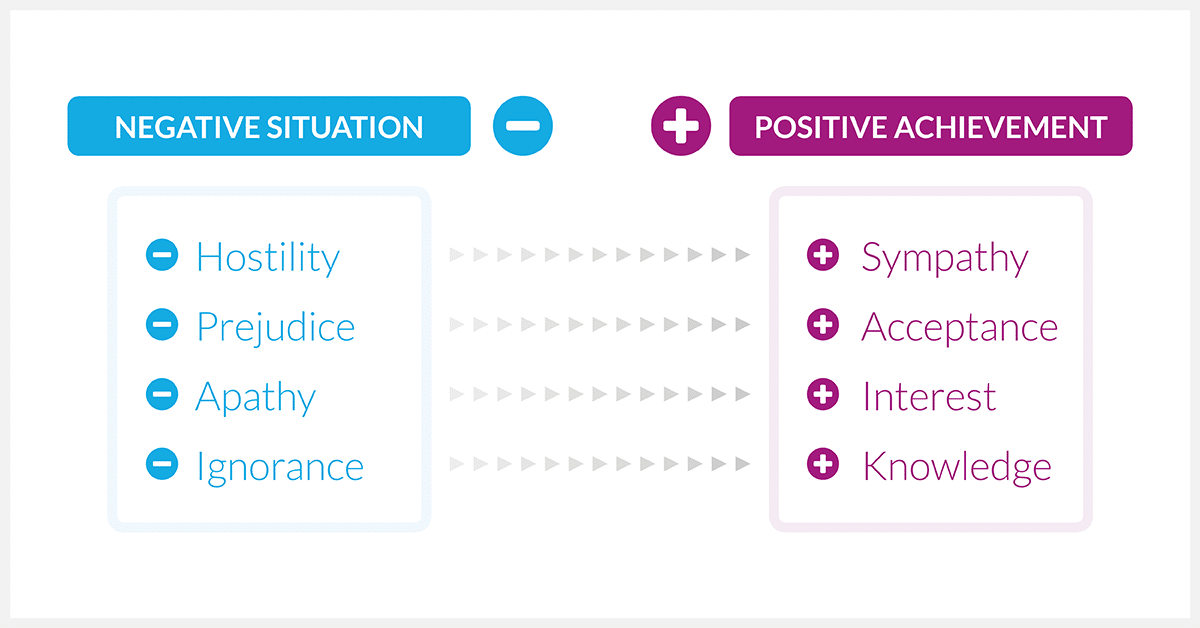
13) Learning lessons
With any crisis there are many valuable lessons to be learned. It is incumbent on the company to sit down and reflect on the crisis and its impact on all stakeholders and not just the company. A report should be drafted on lessons learnt and how to avoid a similar crisis in the future. You should also make any HR changes in terms of delegating PR tasks to a staff member or recruiting an external advisor. Your report should be acted upon as opposed to gathering dust on a shelf or taking up space on a server.
Are there any aspects of this report that you would then share with your stakeholders, would it add value?
14) PR Evaluation of crisis
A full evaluation of the crisis from public relations perspective must be undertaken shortly after it has abated. Identify a person or a team, depending on the size of your company to undertake it and ensure there are clear terms of reference given for this evaluation.
The evaluation should include the media mentions referencing the crisis, the public sentiment around the crisis, and an assessment of how the crisis was handled by the company. You also need to assess the damage done in terms of other aspects of your business which may include:
- Drop in sales
- Lose of customers
- Lose of suppliers
- Damage to stakeholder relationships
- Share price fall
- Reputation damage
- Social media commentary
- Drop in community members (social media, email or mobile marketing unsubscribers, trial subscribers, members)
- Cancellation of speaking engagements
- Removal of sponsorships
- No shows by event attendees
15) Bespoke crisis communications SOP
From your PR evaluation of the crisis you will be able to draw up a standard operating procedure document in the event that another PR crisis hits your company. Document every step that you took throughout the PR crisis, noting which aspects worked and which didn’t and give a rationale for each.
Recruit external expertise to review your PR crisis communications plan to see if it can be improved in any way. Brief all relevant staff on the new document and upskill any staff members that require training.
Expert views
Elena Verlee is founder of a technology PR agency that works with startups to billion-dollar companies. She talks about the 4 A’s when reacting to bad PR. She says that if we are in business it’s inevitable that we will face negativity.
No matter what business you’re in, eventually you’ll piss someone off.
I’m not talking getting bad PR or a major crisis management campaign like laying off 500 people, or having a product recall where you have a gazillion journalists and customers to deal with. I’m talking about preserving your reputation with the more common one-off “your product or service is not good enough” emails or blog comments, your social media network saying your personality leaves much to be desired, or in another scenario, you jump to the next curve and are 10x better than the status quo and well, it tends to rile people up.
It’s always best to plan ahead, but let’s get real…most of the time, we don’t have the time, and are caught reacting to bad PR.
- Act quickly
- Assess the situation
- Admit the truth
- Make amends
Case Studies
I asked my community for their PR crisis experience and case studies and here’s what they had to say. Please feel free to email me your insights to add to this blog post, email [email protected].
Show transparency with information
Provide as much information as possible to your customers. They really value it and it demonstrates trust, transparency and honesty. – Fiona Kearns
Panic – We’re All Human
Case study provided by Jane Morgan of JEM 9 Marketing Consultancy
- Prioritize internal communications. When the dust settles those close to you personally and professionally will still be around.
- Be cogniscent of emotions, your own and others. Shared experiences offer the potential to deepen relationships. And to blow them up.
- Sit down and discuss together what to do: no running up and down corridors. You need (some kind of) a plan.
- Some people are better in a crisis: who may surprise you. That’s ok. It’s team diversity.
- Don’t make stuff up. If it’s sensible to know, make a plan and figure it out.
- Have someone cater for critical needs like eating and tea-making (seriously). It really helps; remember to say thank you.
- Sometime leadership means sending people home so they can be with loved ones and get some sleep.
- Expect some people to take advantage of the situation in a nasty way. Don’t focus on it: unexpected goodness emerges too. Just understand it may happen and be ready.
Conclusion
Nobody or no company is immune from a PR crisis. We never know when we will directly or indirectly be involved in one. But what we can do is that we can plan for a PR crisis and be able to act strongly if and when it happens.
Have you got your PR crisis communications plan in place? If not, what are you waiting for? You are surely not going to wait for a crisis.


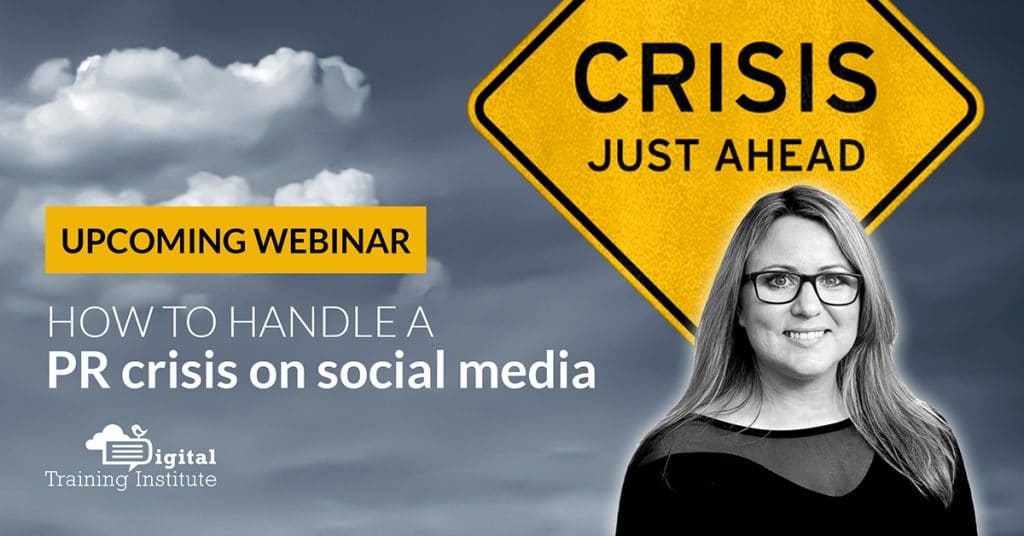
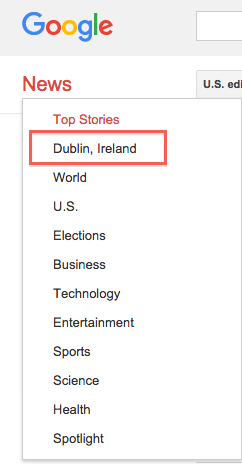

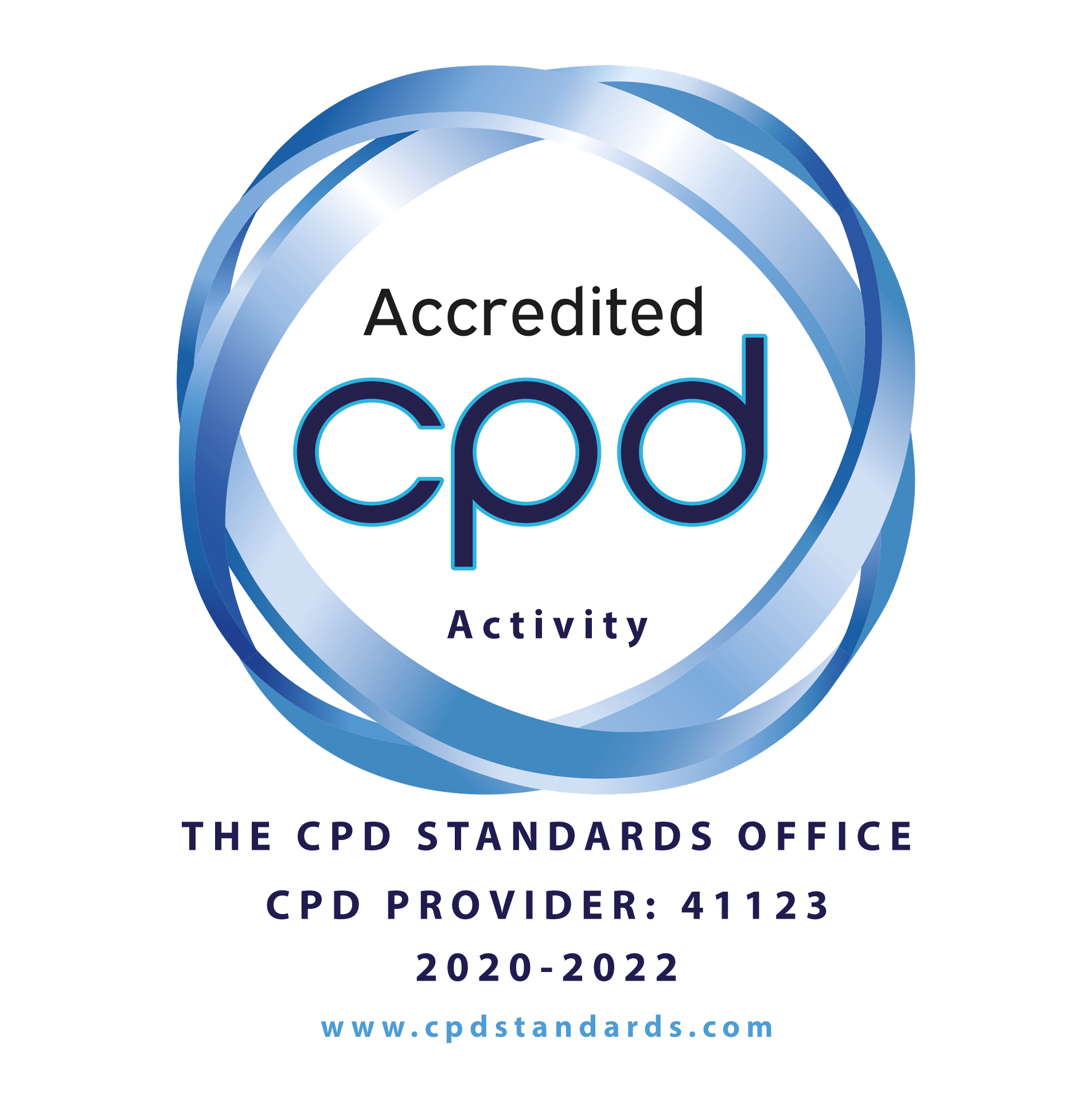





Padraig McKeon
Can’t disagree with a lot of the steps set out here but there is one key and critical point that every organisation should have a laser type focus on when approaching the management of communications in a crisis. Who are the people that really matter to your organisation?. Whether you are working for, or advising, a business, a charity, a political party, a public authority, a pop star – no matter who it is, some group or groups are more important to the future of the organisation than any other, and there are easy to spot because they are the people that were important to the business before it hit the crisis. So, while a crisis excites the interests of many people, none – including media, regulators, investigators etc – are more important than the people that make the organisation a success week in week out. Of course the media etc has to be handled well but if the key existing stakeholders of the organisation are not given priority in communication and told exactly how the crisis will effect them, or not, then when the media have gotten bored and the regulator has done its work, trying to make up to disaffected stakeholders will cost you more time and money than it should. So remember, a key part of that initial fact framing is figuring what impact the crisis will have on all existing stakeholders and investing as much as possible in engaging with them so that they remain with a feeling that they have a stake in the business
Joanne Sweeney-Burke
Hi Padraig, you are completely right. Your internal stakeholders are vital in a PR crisis. That’s why in the first hour – the golden hour – you should reach out to them as suggested.
Pingback:Crisis and Issue Management | Just PR Things